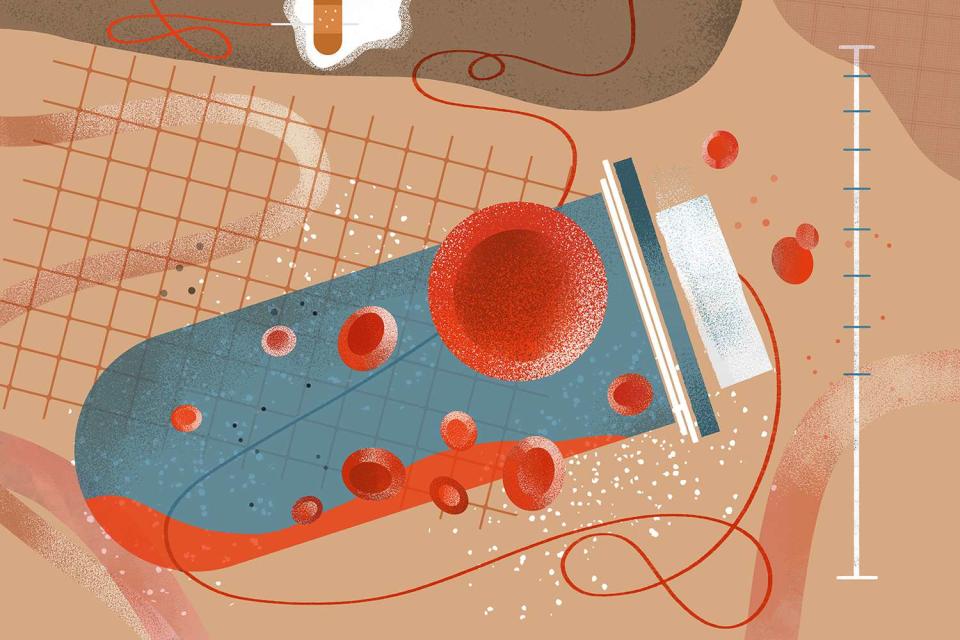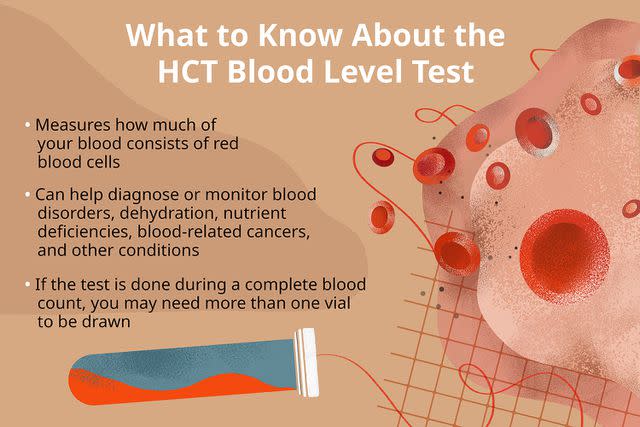Hematocrit (HCT) Blood Test
What to Expect When Undergoing This Test

Illustration by Michela Buttignol for Verywell Health
Medically reviewed by Steffini Stalos, DO
A hematocrit (HCT) test, also known as the packed-cell volume (PCT), measures how much of your blood consists of red blood cells.
Red blood cells carry oxygen from your lungs throughout your body. A low HCT could be due to anemia, a vitamin or mineral deficiency, or blood loss. Having too many blood cells could be a sign of dehydration, heart disease, or polycythemia vera (PV).
This article explores the purpose of the HCT test, the way in which this simple blood test is done, and how results are interpreted by your healthcare provider.

Illustration by Michela Buttignol for Verywell Health
Purpose of the HCT Test
Red blood cells, also called erythrocytes, are important for distributing oxygen from the lungs to the rest of the body. The percentage of your blood that consists of red blood cells also indicates the (viscosity) thickness of blood.
A high or low result on an HCT test can:
Be an early indicator of certain conditions
Help diagnose certain diseases
Reflect a response to certain treatments
What Other Tests Are Done With HCT?
An HCT test is usually ordered as part of a complete blood count (CBC). A CBC provides information on the three major types of blood cells:
Red blood cells (RBC) contain an important protein called hemoglobin that carries oxygen so it can be delivered throughout your body.
White blood cells (WBC) are part of the immune system and protect our bodies from infection and attack by recognizing bacteria, viruses, and cancer cells.
Platelets are responsible for forming clots to stop bleeding and heal wounds.
Other tests may be performed at the same time as the HCT test or as a follow-up to help with a diagnosis. These may include:
A blood smear: This small blood sample is examined under a microscope for signs of problems.
Hemoglobin (Hgb) test: This test measures hemoglobin levels to check for anemia, a blood disorder that's characterized by a low RBC count. When done with an HCT blood test, it is commonly referred to as an H and H test.
Iron studies: A group of blood tests, these are interpreted together to check for iron deficiency or iron overload.
Reticulocyte count: This blood test that determines how well your bone marrow (the spongy tissue inside bones) makes RBCs.
Vitamin B12 and folate levels: This tests to see if you have enough of the nutrients needed to create blood cells.
How Is the HCT Test Done?
As a basic blood test, the HCT doesn’t require fasting or special considerations. Blood is drawn from the inside of the elbow or the back of the hand. With infants and young children, it may involve a small puncture in the heel or fingertip to collect blood onto a test strip.
Related:7 Tips for Making a Blood Draw Easier
How Blood Is Tested
Once your blood is collected, it’s placed in a centrifuge or an automated hematology analyzer instrument.
The centrifuge separates the red blood cells from the plasma (non-cellular liquid), white blood cells, and platelets, giving a direct measure of the percentage of RBCs in the blood sample.
Automated instruments determine the hematocrit (a calculated value) using various methods. Different ways instruments measure/count cells include:
Adding fluorescent reagents
Electrical impedance (Coulter principle)
Laser beam
Whichever method is used, the hematocrit is calculated from the RBC cell count (RBC), mean cell volume (MCV), and the total sample volume (RBC x MCV/10 = Hct).
Interpreting Results
Age and gender affect hematocrit level, but general guidelines for normal levels in adults and young children are as follows:
Age | Normal Levels |
0 to 3 days | 45% to 67% |
3 days to 1 week | 42% to 66% |
1 to 2 weeks | 39% to 63% |
2 weeks to 1 month | 31% to 55% |
1 to 2 months | 28% to 42% |
2 to 6 months | 29% to 41% |
6 months to 2 years | 33% to 39% |
2 to 6 years | 34% to 40% |
6 to 12 years | 35% to 45% |
12 years to adult (females) | 36% to 46% |
12 to 18 years (males) | 37% to 49% |
18 years to adult (males) | 41% to 53% |
HCT test results may be affected by factors such as:
Dehydration
Living at a high altitude
Pregnancy
Recent blood transfusion
Your healthcare provider will take these factors into account when interpreting the results.
If your hematocrit results are outside the normal range, your healthcare provider may have you come in for additional blood tests to help diagnose the cause.
Your healthcare provider may want to repeat the HCT test after weeks, months, or at least annually to monitor your levels.
Causes of High HCT
An above-normal HCT means you have too many red blood cells (polycythemia). Symptoms of high HCT levels include:
Bleeding gums
Blurred or double vision and blind spots
Dizziness or feeling light-headed
Fatigue
Headache
Heavy bleeding from small cuts
Profuse sweating, especially during sleep
Skin symptoms such as itching after a shower or bath, burning, or a red face
Shortness of breath
Vision problems, such as blurred or double vision and blind spots
Weakness
High HCT levels are usually caused by an extended period of low oxygen in the blood. It is often a sign of dehydration. However, it may also indicate a more serious health concern, such as:
Elevated testosterone levels
Obstructive sleep apnea
Polycythemia vera (PV) or other blood-related diseases
Scarring/thickening of the lungs
Smoking
Causes of Low HCT
A low hematocrit number means that your body doesn't have enough red blood cells in your blood. This is also called anemia. Symptoms of anemia include:
Fatigue
Headaches
Dizziness
Feeling cold
Shortness of breath
Anemia may be due to the following health conditions:
Blood loss due to internal or external trauma
Bone marrow damage from chemotherapy or toxins
Immune blood disorders, such as Evans syndrome
Leukemia, lymphoma, or other bone marrow cancers
Nutrient deficiencies, including iron, folate, and vitamins B12 or B6
Too much water in the body
Anemia can also be a side effect of cancer treatments, such as chemotherapy and radiation. Hematocrit results enable healthcare providers to manage anemia if it develops.
For men, an HCT level of less than 41% is considered anemic. For women, that number is slightly lower at less than 36%. The number varies for children depending on their age.
Correcting Abnormal HCT Levels
If your HCT levels are abnormal, your healthcare provider may order additional tests to identify and treat the underlying cause.
For example, if test results point to a bone marrow problem, a bone marrow examination may be needed. A sample of bone marrow is taken, usually from the hip, to check for lymphoma and similar disorders.
In addition to treating the underlying cause, your healthcare provider may recommend diet or lifestyle changes, supplements, or medications.
How to Increase HCT
If your results, along with other tests, indicate that you have iron-deficiency anemia, you can usually improve your red blood cell count by fortifying your diet with iron-rich foods.
Some examples of iron-rich foods include:
Red meat
Chicken
Liver
Eggs
Shrimp
Tuna
Spinach
Peas
Broccoli
Whole wheat bread
Tofu
Beans
Your healthcare provider may also suggest taking over-the-counter iron supplements. If iron deficiency anemia is severe, a blood transfusion may be needed.
If anemia is the result of a bacterial infection, you may need to begin antibiotics.
How to Lower a High HCT
If you have a condition that causes overproduction of RBCs, your healthcare provider may suggest lifestyle changes such as quitting smoking or adopting a heart-healthy diet.
Sometimes dehydration can cause high hematocrit levels. In this case, drinking lots of fluids can bring your levels back to normal.
In the rare case of PV, a healthcare provider can provide medication that will help you manage the condition, but it cannot be cured.
Related:What to Eat When You Have Iron Deficiency Anemia
Summary
A hematocrit test gives your healthcare provider important information about your health. The test measures red blood cells, which have a protein that delivers oxygen throughout your body.
The HCT test can help to diagnose or monitor blood disorders, dehydration, nutrient deficiencies, blood-related cancers, and many other conditions.
If your test results are abnormal, other tests may be performed at the same time or afterward to help identify the cause of anemia (low hematocrit) or high red blood cell counts, so you can get the right treatment.
